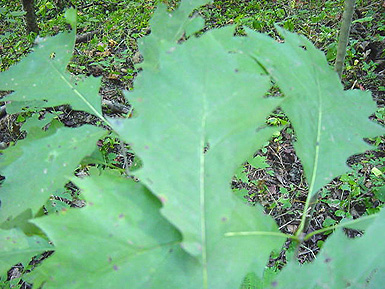Form: This is a medium sized tree reaching heights of 60 to 80 ft. and a 2 to 3 ft. dbh. It has a short trunk with an open rounded crown.
Leaves:
Arrangement: alternate, simple
Shape: oblong-obovate; 7-11 lobed; bristle tipped
Margin: entire
Texture: glabrous except for axillary tufts
Venation: pinnate

Bark: The bark is dark gray in color with shallow furrows that can resemble ski trails.
Twigs and buds: The twigs are moderately stout with a reddish brown color. This species has multiple terminal buds that are sharp pointed and reddish in color.
Flowers and fruit: Flowers are borne on catskins and are staminate. The fruit is an acorn, that occurs in pairs or solitary. The acorn is about 1 in. in length and the cap is saucer-like with pubescent scales at the tips.
Distinguishing characteristics: This species has distinctive oak leaves and a saucer like cap on its acorn.
Range: This species is found from Maine to Georgia and west to eastern Nebraska.
Silvics: This tree has an intermediate tolerance and occurs on mesic to moist upland soils, coves, and mountain slopes. However, it grows best on northerly and easterly aspects.
Ecological and cultural importance: This species is an important source of hardwood lumber and is used in veneer, furniture, pulpwood, and flooring. White-tailed deer browse leaves and seedlings. Elk and moose also browse this tree in its northern regions.